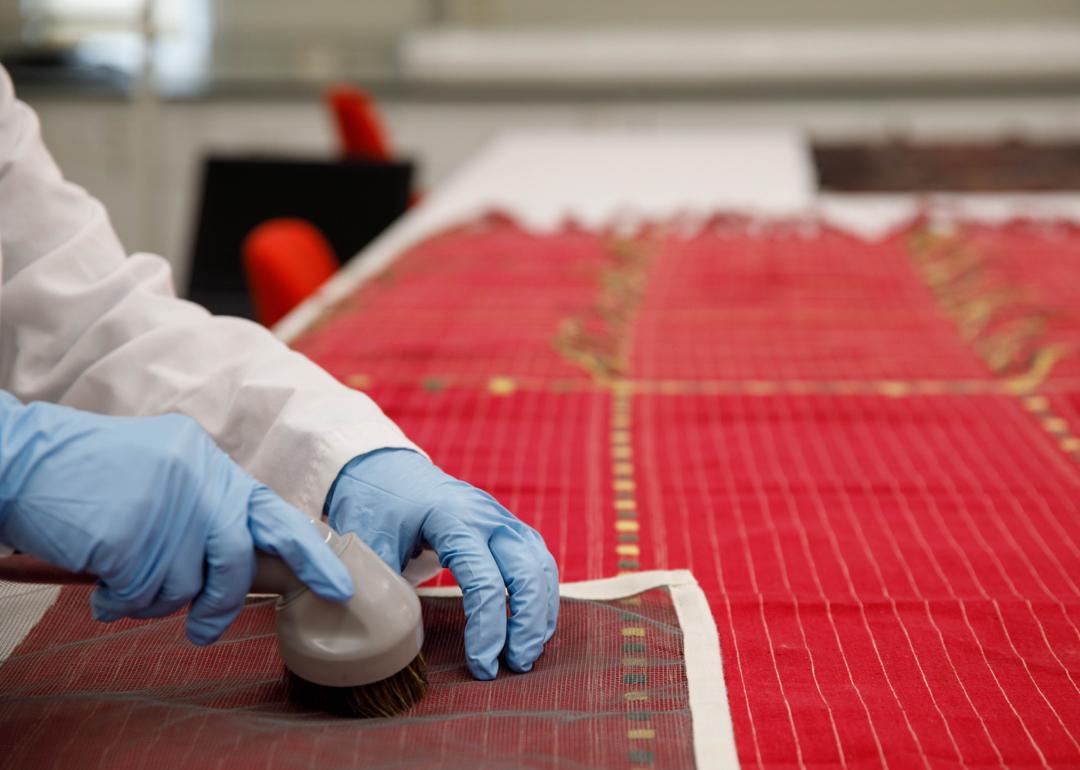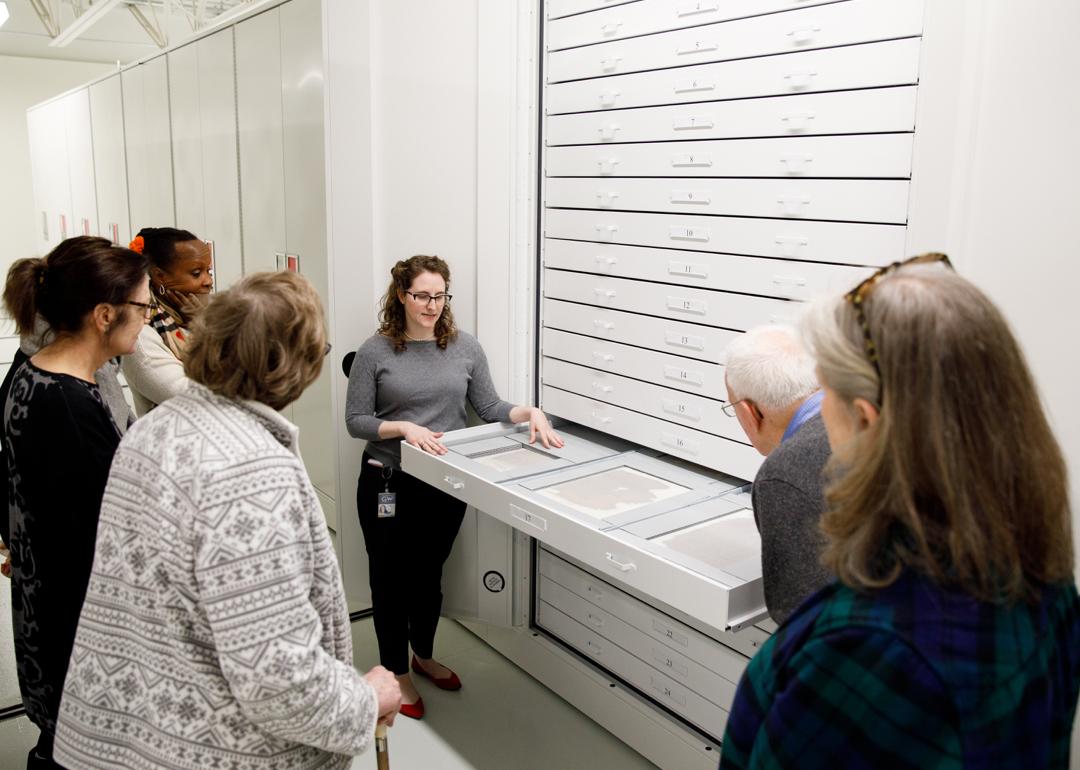Displaying Textiles
There are a number of ways to safely display a textile. These guidelines will help you choose the best option for your piece based on its size, weight and condition. You can also refer to the American Institute for Conservation's "find a conservator" service to find a conservator in your local area.
Hanging Textiles
A variety of systems can be used to hang textiles and rugs for display. A VELCRO® mount is the technique of choice for most conservators for these reasons:
- It is relatively easy to execute.
- The points of stress on the hanging edge are minimal.
- It allows for adjustments and repositioning to compensate for dimensional movement and ripples in the textile caused by changes in humidity, or owing to the natural uneven quality of many handmade textiles.
However, the VELCRO® mount method is not appropriate for all textiles. Evaluate your textile carefully to see if it can truly support its own weight. If in doubt, consult a conservator to select an appropriate hanging method. The VELCRO® mount method is most often recommended for sturdy blankets, quilts and rugs. It is not appropriate for thin or fragile textiles, such as silk, or for textiles with heavy surface embellishments like beads.
Garments with simple construction, such as tunics, ponchos and kimonos, can be mounted on the wall on a padded rod. Either an acrylic rod or a wooden dowel covered in Marvelseal® can be used. Pad the rod with polyester quilt batting to round out the shoulder areas, and cover it with a piece of washed, unbleached muslin. This is particularly important when using a wooden dowel.
Mounting Textiles
If your textile is not sturdy enough to be hung safely from a VELCRO® fastener strip, it can be mounted one of several other ways.
Large textiles that are not strong enough to hang from one end can be mounted on a support, ideally one that is chemically inert, such as an aluminum honeycomb panel, over which mounting fabric has been stretched.
Small textiles can be mounted to a fabric-covered archival matboard. This type of mount is generally only appropriate for textiles that will be framed, as the matboard easily absorbs moisture and can warp if not restrained within a frame. You carefully sew the textile to the stretched fabric in such a way as to provide overall support to the textile. Sewing tension and position of stitches have to be carefully selected and executed.
Textiles that are too fragile to bear stitching may be pressure mounted, a system where contact pressure alone secures the textile. This complex mounting system should only be attempted by a conservator. The textile itself should never be stretched around the edges of the strainer. Depending on its size, the mounted textile can be framed or glazed.
Archival Display Materials
It is important to use the appropriate materials for your mount. Try to avoid wooden materials. If wooden supports need to be used, the wood should be sealed with Marvelseal® (an aluminized polyethylene and nylon barrier film) to seal in wood acids. Mounting fabrics must be pre-washed to remove excess dyes, finishes and sizings. The best choices for mounting fabrics are 100 percent cotton or cotton/polyester blends. Linen is not an appropriate mount fabric because it easily absorbs moisture from the environment, causing sagging and distortion. Wool also sags easily, and along with silk, is susceptible to insect attack.
These trusted providers are an excellent source for the archival materials needed to care for your collection.
Gaylord Archival
P.O. Box 4901
Syracuse, NY 13221-4901
800-448-6160
Light Impressions
2340 Brighton Henrietta Town Line Rd.
Rochester, NY 14623
800-975-6429
University Products
P.O. Box 101
517 Main St.
Holyoke, MA 01041-0101
800-336-4847
Hollinger Metal Edge
9401 Northeast Dr.
Fredericksburg, VA 22408
800-634-0491
TALAS Supplies
330 Morgan Ave.
Brooklyn, NY 11211
212-219-0770
Framing Textiles
Should a textile be framed behind glass? This is one of the most common questions when considering how to display textiles, with more than one answer. Before you make a decision, consider:
- Location: Will the textile be illuminated by natural daylight? If so, it is best to use a glazing material like acrylic sheeting (plexiglass) that contains an ultraviolet filter to reduce damage from at least that portion of the light spectrum.
- Size: The standard size of a piece of acrylic is 4 by 8 feet, and it is difficult to obtain glazing material beyond this size.
- Environmental control: If dust and dirt are problems, or if someone smokes in your house, glazing is recommended. Without this kind of protection, your textile may need more frequent cleaning.
- Drape: Handmade textiles are often irregular in shape and may tend to ripple as they hang on the wall. If this three-dimensional character is an important part of the presentation of the textile, it is best hung without framing.
In choosing a glazing material, acrylic is usually preferable to glass. Acrylic does not break easily. Irreparable damage can occur if glass breaks and tears through a textile. In addition, acrylic is significantly lighter in weight than glass, which can make it easier to handle when hanging larger framed pieces.
However, acrylic glazing has electrostatic properties. These can pull loose fibers of a textile onto the inside surface of the acrylic unless it has an anti-static coating (e.g., Tru Vue StaticShield® acrylic). In addition, acrylic surfaces are more easily scratched than glass.
Glass glazing is sensitive to temperature change. When glass is in direct or close contact with your textile, differences in temperature can cause condensation. Salts or fatty acids in the textile may transfer to the glazing creating a clouded appearance. The presence of moisture (condensation) could also be conducive to mold growth on the textile itself.
To separate the glazing from your textile, a window mat (such as those used in mounting prints and drawings) or a spacer made of archival materials (e.g., acrylic or archival matboard) should be included in the frame. A conservator or framer can help you decide which method is best.
Pressure mounts are an exception to this rule and can be used to frame fragile textiles. The textile is placed on a padded support, and a sheet of acrylic is placed directly on top. The frame exerts gentle pressure on the acrylic, holding the textile in place on the mount. A conservator should be consulted to evaluate whether this type of mount is appropriate for a specific textile.







